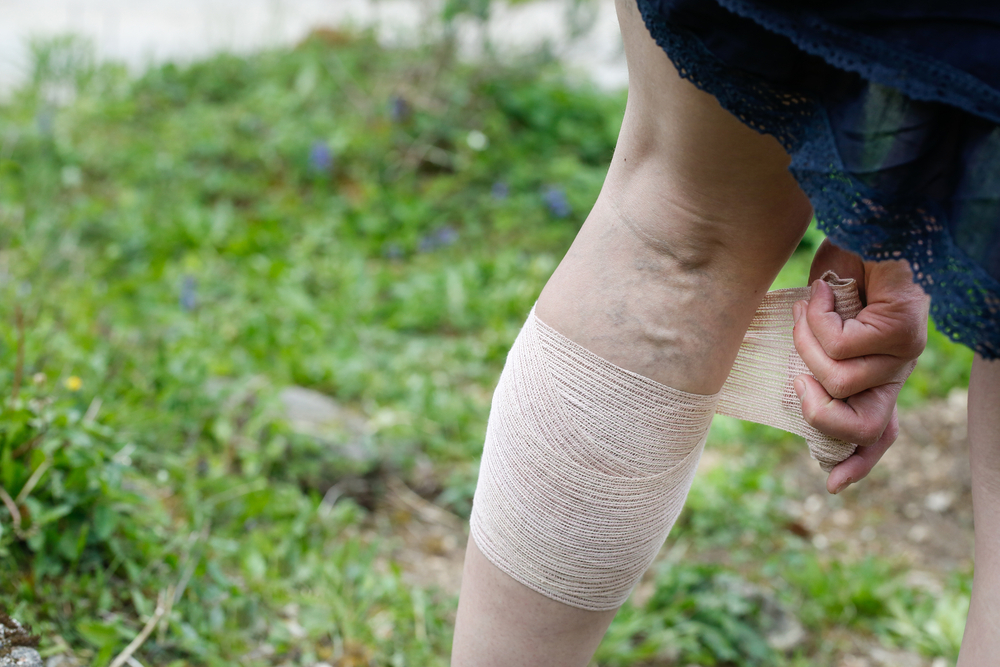If you have a sore on your leg that refuses to heal, you may just brush it off as a slow-healing wound. However, a wound that refuses to heal may actually be a venous ulcer. Venous ulcers are a common and potentially serious complication of long-term venous insufficiency.
Venous insufficiency is a condition in which the veins cannot pump enough blood back to the heart, often due to damage or obstruction from damaged valves. Venous ulcers form when the skin overlying a vein becomes damaged and breaks down.
Learn what you need to know about venous ulcers, including symptoms and treatment options.
THE ANATOMY OF A VENOUS ULCER
A venous ulcer, also referred to as a stasis ulcer, occurs when the vein in your leg neglects to force the blood in the vein back to your heart. This causes pressure to build up within the vein, eventually resulting in the appearance of a sore on the skin as the blood and fluid leak into the surrounding tissues.
A shallow wound develops when the skin and underlying tissue over a vein break down, and this sore is the venous ulcer.
Venous ulcers are most commonly found on the medial (inner) aspect of the leg, just above the ankle. However, they can also develop on the outer aspect of the leg or anywhere else there is venous insufficiency.
SYMPTOMS OF A VENOUS ULCER
Most venous ulcers are asymptomatic in the early stages. However, as the ulcer progresses, you may begin to experience some symptoms. The earliest symptoms of a venous ulcer include swelling and cramping in the leg. Your leg may feel heavier than normal, and you may have itching or tingling.
Right before the venous ulcer starts to break through your skin, you’ll notice a red, blue, or purple spot underneath the skin similar in appearance to a bruise. This colored spot breaks through the skin, creating a sore that won’t heal on its own. Once the sore appears, expect your pain levels in your leg to intensify.
Signs of a venous ulcer include:
- A dull ache or feeling of heaviness in the leg
- Swelling of the leg
- Cramping or pain in the leg
- Itching or burning sensation on the skin over the ulcer
- Discoloration of the skin around the ulcer
- Bad odor coming from the ulcer
If you have any of these symptoms, it is important to see a doctor so they can properly diagnose and treat your venous ulcer.
CAUSES OF VENOUS ULCERS
A number of different factors contribute to the formation of a venous ulcer, like a blood clot, trauma to the leg, and inflammation. Most of the causes of a venous ulcer ultimately decrease the body’s ability to effectively pump blood, resulting in poor circulation or the body’s inability to maintain the correct blood pressure.
Damage to the veins interferes with the body’s ability to control the pressure in the veins. Uncontrolled pressure means that the blood may flow in the wrong direction. If your body can’t circulate your blood correctly, blood may build up in your veins. This condition is called venous insufficiency.
Common causes of venous ulcers include:
- Venous insufficiency
- Deep venous thrombosis (DVT)
- Trauma to the leg
- Inflammation
- Obesity
- Smoking
- Pregnancy
- Age
- Sedentary lifestyle
- Chronic venous hypertension
- Venous reflux disease
MINIMIZING RISK FACTORS FOR VENOUS ULCERS
There are a number of different factors that can increase your risk of developing venous ulcers. Some of these factors are out of your control, like age and family history. However, you can make some lifestyle choices to decrease your risk, like quitting smoking and maintaining a healthy weight.
The most common risk factors for venous ulcers include:
Age
The older you are, the greater your risk of developing venous ulcers. This is because the valves in your veins weaken as you age, making it more difficult for your blood to flow in the correct direction. While there isn’t much you can do about aging, you can take steps to get proper vein health screenings regularly. Doing this self-care will help you identify vein issues before they become a greater health problem.
Family history
If someone in your family has had venous ulcers in the past, you have a greater chance of developing them as well. This may be due to genetic factors or lifestyle choices that are passed down from generation to generation. Again, getting screenings from a vascular health surgeon will help you stay on top of your vein health.
Smoking
Smoking damages the walls of your veins and reduces blood flow, both of which can increase your risk of developing venous ulcers. Smoking is unhealthy for so many other reasons as well. Your best bet is to quit. This is easier said than done, but it is possible.
Obesity
Being overweight or obese puts extra pressure on your veins, making it more difficult for your blood to flow properly. This increases your risk of developing venous ulcers. Look for ways to eat healthily and exercise on a daily basis. You may need to enlist the help of a nutritionist or other weight-focused doctor to get your weight in check.
Pregnancy
The added weight and pressure of pregnancy can put a strain on your veins and lead to venous ulcer formation. Take as much time as you can to elevate your feet and avoid standing for long periods of time.
Sedentary lifestyle
If you have a sedentary lifestyle, you’re at a greater risk of developing venous ulcers. This is because sitting or standing for long periods of time can decrease blood flow and lead to venous insufficiency. Make sure to stand up if you have a desk job and try to fit some walks into your daily schedule.
Trauma
Any type of trauma to the leg, like a cut or bruise, can damage the veins and lead to venous ulcer formation. If you have been injured, you should get a screening to ensure your veins are moving blood through your body effectively.
Infection
If you have an infection in your leg, it can damage the veins and lead to venous ulcer formation. See a doctor immediately if you think you might have an infection in your skin or veins.
Inflammation
Inflammation of the veins (called venous inflammation) can damage the valves and lead to venous ulcer formation. You can reduce inflammation by elevating your legs, wearing compression stockings, keeping active, and icing the area.
Chronic venous hypertension
This is a condition in which the veins are unable to pump blood back to the heart properly, leading to venous ulcer formation. Avoid sitting or standing for long periods. Take a break to get up and walk or sit every 30 minutes.
Venous reflux disease
This is a condition in which the valves in the veins are damaged, causing blood to flow backward and pool in the veins. This can lead to venous ulcer formation. One easy way to deal with this is by wearing compression stockings. Surgery is another option for more advanced venous diseases.
If you have any of these risk factors, it’s important to see a doctor so they can properly diagnose and treat your venous ulcer.
COMPLICATIONS
If you have venous ulcers, it’s important to see a doctor so they can properly treat the ulcer and prevent complications. Left untreated, venous ulcers can lead to a number of complications, including:
Infection
If the ulcer becomes infected, it can become more painful and take longer to heal. The infection can also spread to the surrounding tissue.
Cellulitis
This is a bacterial infection of the skin that can occur if an ulcer becomes infected. Cellulitis often requires antibiotics to clear up.
Sepsis
This is a potentially life-threatening condition that occurs when an infection spreads through the body. Sepsis often requires hospitalization and intravenous antibiotics.
Amputation
In severe cases, venous ulcers may lead to amputation of the affected limb. This is usually only done as a last resort.
With proper treatment, venous ulcers can heal within a few weeks to a few months. Complications are rare but can occur if the ulcer is left untreated. If you have any concerns, be sure to discuss them with your doctor.
TREATMENT OPTIONS FOR A VENOUS ULCER
Treatment for a venous ulcer requires a combination of wound care and managing the underlying causes of the ulcer. Once you have an open venous ulcer, you’ll need to take steps to keep it from getting infected. This involves regularly cleaning and dressing the wound.
You should also try to keep the area around the venous ulcer dry; wet skin is softer than dry skin, and the softness makes it easier for the ulcer to grow in size. Regularly wearing compression stockings can keep blood from continuing to pool in the leg. Some patients find that propping the leg up can hasten the healing process.
Your vein specialist may perform surgery on the vein leading to the venous ulcer if conventional treatment options aren’t working, if the ulcer continually reappears, or if the ulcer is large or infected. Surgery focuses on opening the vein so that it has better blood flow.
OTHER TECHNIQUES TO PREVENT A VENOUS ULCER
There are a few things you can do to prevent a venous ulcer from appearing or reappearing. If you smoke, now is the time to stop. Smoking is known to make it harder for your body to heal, and it can affect your body’s ability to circulate your blood.
Take steps to lose weight if you’re overweight or obese. This decreases your chances of suffering from conditions that can impede your circulatory system. Regular exercise is another option to promote a healthy circulatory system.
If your body is prone to developing inflammation, your doctor may suggest anti-inflammatory lifestyle changes, such as altering your diet.
Have problematic venous ulcers that need attention? Contact the Vein Centre today to schedule an appointment.



